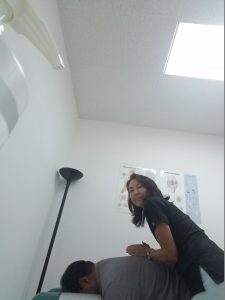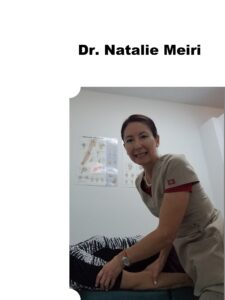
Chiropractic physicians are “primary contact providers” which means you can go directly to your chiropractor for an examination, diagnosis and treatment. In Florida, there is a large scope of practice besides from spinal and extremity (limb) adjustments (chiropractic joint manipulation): various manual therapies, physiologic therapeutics, exercise, nutritional/dietary counseling, and natural medicine (e.g. homeopathy). Although there is a great difference in each chiropractor’s practice, nearly all utilize manual therapy with an emphasis on adjusting techniques.
What is Manual Therapy?
Manual therapy includes all procedures that use the hands to mobilize, adjust, manipulate, create traction, or massage the somatic (joint or soft tissue) or visceral structures of the body.
The aim is to get joint motion through either nonthrust techniques (mobilization) or thrust techniques (chiropractic adjustment/ thrust manipulation). Furthermore, these procedures improve range of motion as well as the quality of motion. So by normalizing function, the pain goes away. Indeed, manual therapy is a treatment for Neuromusculoskeletal disorders with joint pain and dysfunction.

The Chiropractic ADJUSTMENT
Central to the practice of chiropractic, it is the chiropractor’s specialty. Moreover, adjusting procedures are a key distinguishing feature of chiropractic practice. Chiropractors commonly use such procedures to influence joint and neurophysiologic function.
However, most chiropractors do not limit their practices to solely adjustments. Many conditions require additional therapy (e.g. electric muscle stimulation, soft tissue techniques, therapeutic exercise, ice/heat therapy, lifestyle/nutritional/ergonomic counseling, homeopathy).
Chiropractic Technique
More than 100 different named chiropractic technique systems have been developed within the chiropractic profession. These systems are a wide variety of diverse procedures: thrust and nonthrust joint manipulation/adjustment, soft tissue manipulation, manual or motorized traction, etc. And they all involve force, leverage, direction, amplitude, and velocity.
Many chiropractors do not equate an adjustment with a thrust. In fact, some chiropractic technique systems do not incorporate thrust procedures at all. However, it is the thrust attribute that is a central distinguishing feature of the chiropractic adjustment. What’s more, the amplitude and velocity of the adjustive thrust vary depending on the patient’s need and condition (e.g high velocity–low amplitude (HVLA) force of controlled velocity, depth, and direction).
Certainly, the adjustment is a specific form of direct articular manipulation, using either long-or short-leverage techniques with specific contacts characterized by a dynamic thrust of controlled velocity, amplitude, and direction.
Some Techniques
Flexion Distraction (COX) Technique/Motorized Lumbar Distraction/ Manual or Motorized Cervical Traction
First, Flexion-distraction is a mechanically assisted form of joint mobilization or distraction. It has been advanced in chiropractic by the work of chiropractor James Cox.
Second, Motorized Lumbar (low back) Distraction can be used to assist in the production of lumbar traction. Traction to the lumbar spine is applied in the prone (face down) position while the pelvic section of the table produces continuous passive motion in the long axis of the spine.
Third, Manual Cervical (neck) traction can be applied manually or with mechanical assistance. Manual cervical traction is generally accomplished with the patient in the supine (face up) position.
Fourth, Traction and Distraction techniques restore normal physiological range of motion to the cervical (neck), thoracic (mid back) and lumbar (low back) spinal joints. The manipulation is a gentle, non-force adjusting procedure that works with the body’s natural design to aid in healing.
Finally, these techniques transfer metabolites into the spinal disc, decrease intradiscal pressure and decompress inflamed or compressed spinal nerve roots.
Diversified Chiropractic Technique
This is one of the most commonly used techniques in chiropractic. It involves application of “a short (low-amplitude), quick (high-velocity) thrust over restricted joints (one at a time). Of course the goal is to restore normal range of motion in the spine and extremity joints.
Musculoskeletal disorders, Migraine headaches, Pregnancy-related issues, inward curvature of the neck are all conditions which respond to this technique.
Thompson Technique
Thompson Technique uses an adjusting table with a pneumatically driven, segmented drop system. Next using minimal force, the doctor thrusts at high speed, allowing the fast drop to carry the joint through its range of motion. It is a gentle and effective technique.
Sacro Occipital Technique (SOT)
It was developed by Bertrand DeJarnette, DC. SOT believes adjusting one segment of the spine can cause change in another.
Dr. DeJarnette theorized that structural changes of the cranial bones could affect the movement of cerebrospinal fluid. Thus, SOT addresses the positioning of the cranial bones using a method called craniopathy.
SOT addresses pelvic subluxations by blocking. This involves blocks placed beneath the pelvis with the patient lying face-up. Above all, SOT integrates with other chiropractic systems, allowing for use of a variety of techniques within the SOT system.
Instrument Adjusting
A small handheld spring-loaded adjusting instrument is used. It delivers a controlled and reproducible impulse to the spine and extremities. This is an alternative to manual manipulation of the spine or extremity joints. Surely, Instrument Adjusting has grown to become one of the most commonly used in today’s practice (National Board of Chiropractic Examiners Survey, 2000). Similarly, this technique offers the flexibility to perform a chiropractic adjustment on a variety of patients, regardless of age or condition.

Chiropractic in West Palm Beach: Various Adjustments and Techniques
Dr. Natalie Meiri is a graduate of New York Chiropractic College (NYCC). And all the techniques above are part of the NYCC curriculum. In addition to joint manipulation and adjustment to the spine and peripheral joints, at Meiri Chiropractic, we use soft tissue procedures, hot and cold modalities, stretching exercises, rehabilitation exercises, and homeopathic consultations.
At Meiri Chiropractic in West Palm Beach we spend the time necessary to examine, diagnose and treat every neuromusculoskeletal condition and various ailments you have. Through regular chiropractic visits, you can get pain relief and improve function. Chiropractic is a holistic and natural way to not only treat existing conditions, but to keep your body in its best working condition. Meiri Chiropractic has been offering effective chiropractic care in Palm Beach county since 2006. Many of our patient reviews note our excellence. Call us today at 561-253-8984 in West Palm Beach to make an appointment or to find out more about Chiropractic in West Palm Beach: Various Adjustments and Techniques.